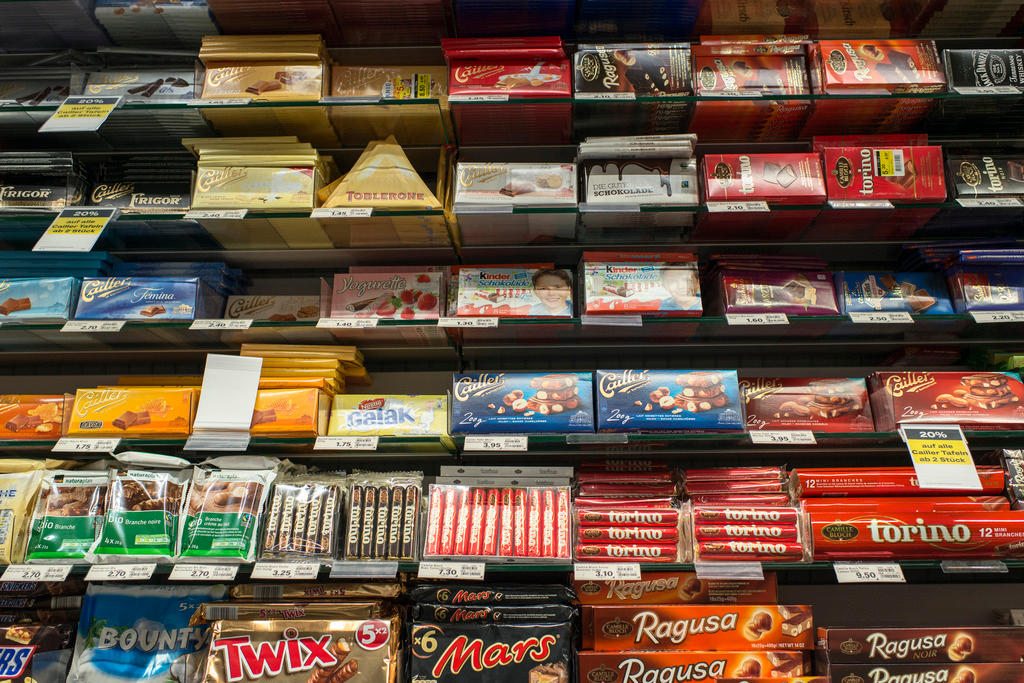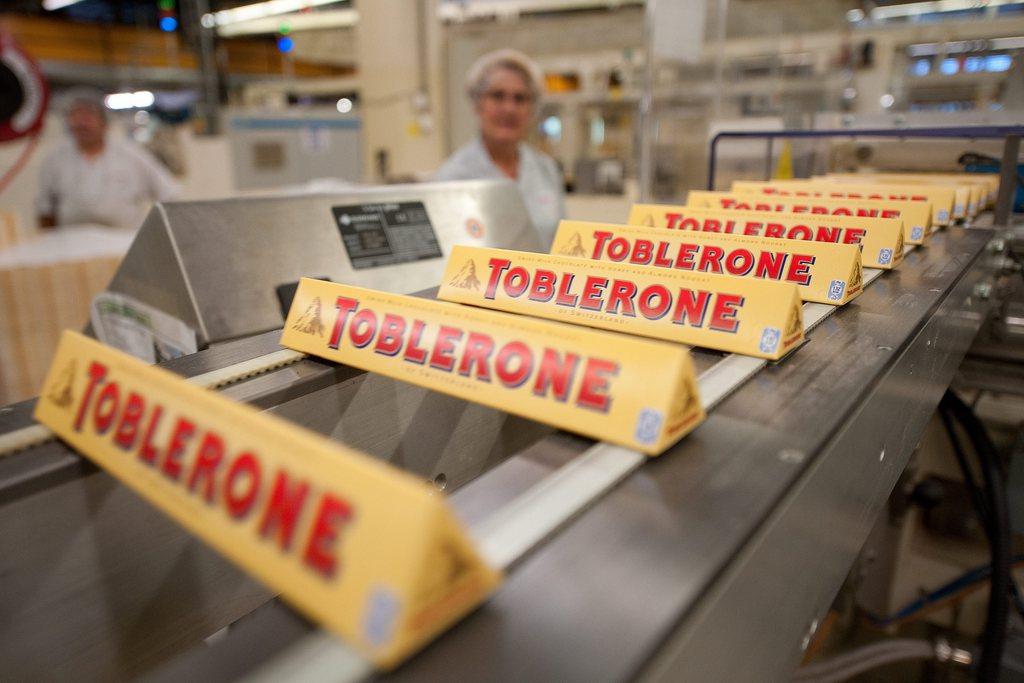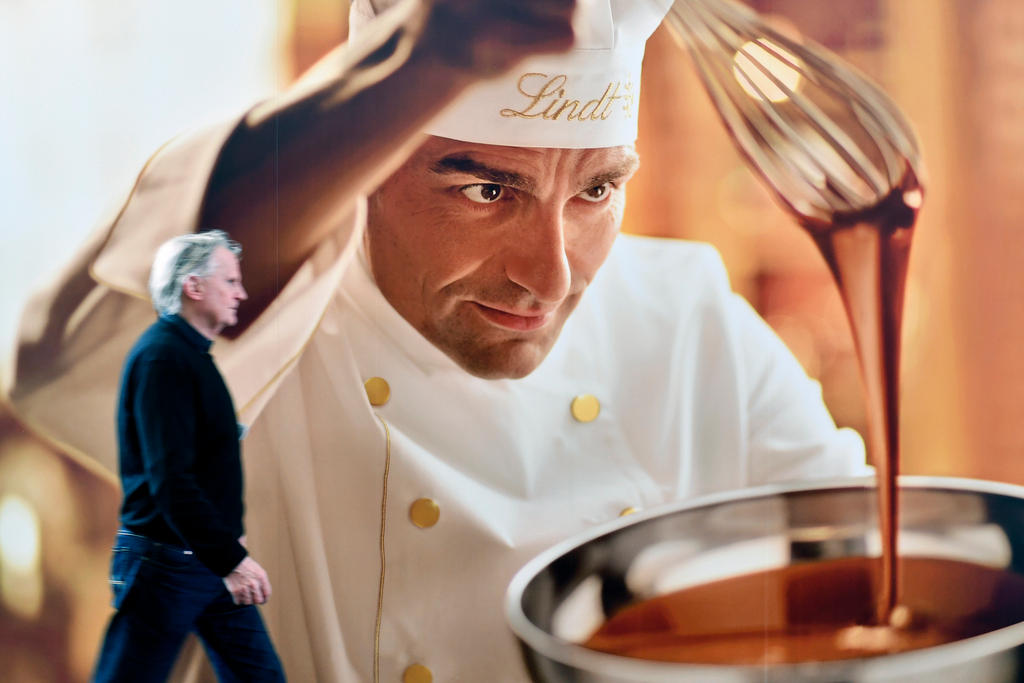
Swiss chocolate sees its magic melt

The run-up to Easter is a busy time at the Lindt & Sprüngli chocolate factory just outside Zurich, the sort of blend of modernity and tradition to which Swiss industry aspires. As robots pack pralines into boxes – Lindt’s global output also includes 140 million gold-foil wrapped chocolate rabbits a year – the mechanical workers enjoy sweeping views across a dreamy Lake Zurich, the air sweet with the smell of cocoa.
But the chocolate magic may be melting. Around the world, health-conscious consumers are cutting back on sugary products. Steep rises in the price of cocoa beans in recent years and competition among high street retailers have eroded profit margins, while sputtering economic growth in the biggest markets has dented sales. Affluent consumers are also turning to small, local “craft” makers of handmade – not robot-made – chocolate.

More
Financial Times
External linkThe dilemma faced by Swiss chocolate-makers is playing out across the food sector as tastes shift and the “war on sugar” forces everyone from wheat traders to the makers of Campbell Soup to rethink their business models.
“The US-led trend towards healthier snacking, stagnating markets, aggressive pricing by hard discount retailers – all these factors are making life less comfortable [for Swiss chocolate],” says Jean-Philippe Bertschy, analyst at Vontobel in Zurich.
As a result, Swiss chocolate producers are scrambling to position themselves for a changing market. Lindt, which saw organic sales growth slow to 6% last year and its shares fall 12% from their peak in December 2015, is still betting on premium products.
“We’re not in that [mass] market,” says Ernst Tanner, executive chairman of Lindt. “We’re really for when you want to indulge yourself, you want to relax, to forget the world and just have a moment of peace or enjoyment.”
Across Switzerland, the problems are worse. Nestlé, the world’s largest food and drink company, headquartered by Lake Geneva, has been left trailing in the premium chocolate market. It relaunched its Cailler brand in 2015, but Mark Schneider, chief executive of the company behind Smarties and KitKat, may have to take radical steps to catch up – perhaps through acquisitions or an exit of some markets such as the US.
Branding
Chocolate may not be the country’s biggest employer but it has become a central part of Swiss branding. Along with the Alps, cows and luxury watches, chocolate is part of Switzerland’s reputation for good living and a welcome contrast from the country’s other image: as a haven for secretive bankers and tax evaders.

More
‘Chocolate Law’ subsidy stays sweet for food manufacturers
If Switzerland were to lose its edge in premium chocolate making, it would end almost 200 years of tradition. Switzerland does not grow cocoa beans but it invented milk chocolate in the late 19th century – the result of engineering ingenuity and a surplus of milk from cows reared on its mountain pastures.
“Chocolate’s a small part of the economy but for the image, it’s huge,” says Nicolas Bideau, head of Presence Switzerland, which monitors how the country is viewed abroad. “Nations that are related to food have something more positive than others – it triggers emotions, memories and empathy.”
The Swiss government still provides substantial agricultural subsidies – a Schoggigesetz, or chocolate law, ensures Swiss-produced ingredients can compete against imports – although under pressure from the World Trade Organization they are being phased out.
“Like watchmaking, it’s very important to us as Swiss. It’s important we have good people who want to live and celebrate chocolate,” says René Rechsteiner, retail director at Läderach, a premium chocolate maker with 52 shops in Switzerland and Germany. Ernst Tanner at Lindt adds: “Yes you have great Belgian truffles [for example], but [in Belgium] you don’t have a brand that identifies with the country as much as Lindt does.”
Slowdown
When global chocolate consumption was growing rapidly, expansion was easy for the Swiss companies. In the first decade of this century, Swiss chocolate exports expanded at double-digit growth rates.
But now there are clear signs of a slowdown. Global chocolate sales are expected to increase by less than 2% this year, less than half last year’s rate, largely because of a deceleration in the biggest markets such as the US, the UK and other advanced economies, according to Euromonitor. Sales growth is also slowing in emerging markets such as China, India and Brazil where consumption remains far below US and western European levels.

More
Where is Swiss chocolate most popular?
The fall can be explained by lifestyle trends as well as macroeconomic factors, says Pinar Hoşafçi, food analyst at Euromonitor. “Consumers worldwide are becoming increasingly sceptical about foods that include added sugar, which is really hitting the chocolate and biscuit market,” she says.
Lindt is convinced that the shift in consumer tastes will not hamper the growth potential from consumers “trading up” – switching to higher-quality products as their incomes rise. “We still have lots of headroom to grow,” says Dieter Weisskopf, the group’s chief executive. Even in Germany and the UK, where per capita chocolate consumption is already high, and discount retailers such as Aldi and Lidl are well established, Lindt’s sales rose by 10% and 14% respectively last year.
The focus on quality chocolates could provide some protection against the impact of healthier eating. If consumers eat less, they will favour quality over quantity and products containing nuts or fruit (pink grapefruit flavoured chocolate is one latest trend). Lindt sees its chocolates as indulgences, rather than pretending they are healthy.
The group could also be helped by the trend towards dark chocolate, which is perceived as healthier because of its lower sugar content. In the late 19th century, Rodolphe Lindt, one of the company’s founders, developed the original processes for stirring chocolate in “conches” to produce a smooth melting texture. With a higher percentage of cocoa solids, the taste of dark chocolate depends more than milk chocolate on the quality of beans and manufacturing skills – favouring “premium” manufacturers.
“To produce dark chocolate, you need more know-how than for milk chocolate,” Weisskopf says.
Premium markets
Nevertheless, Lindt faces headwinds. US expansion has proved difficult. Lindt acquired Russell Stover in 2014 for an estimated $1.4 billion (CHF1.41 billion) but merging the American producer into the group has diverted management attention. Lindt’s like-for-like North American sales rose by a modest 3.4% last year.

More
Peak Brexit? Toblerone redesign angers British fans
“Even when you know the market and environment, an integration always takes longer than one thinks,” says Weisskopf. “The strong slowdown in the US chocolate market didn’t help.”
Competition is likely to intensify in the US. Mondelez, the much larger US company behind brands such as Oreo biscuits and Cadbury chocolate, announced plans in September to expand US sales of its upmarket Green & Black’s premium chocolate. Mondelez also makes Toblerone, the iconic Swiss-made bars shaped like Alpine mountains, which have become more “premium” in the UK after they were reduced in size last year.
Lindt is also trailing rivals in China and other emerging markets, which could prove a significant disadvantage if rising incomes lead to growing appetites for quality chocolate. The company’s signature pralines are expensive to transport and store in hot climates, while Mars, Mondelez and Lindt’s European rival, Italy’s Ferrero, are better established in China and India.
“Some markets don’t yet have a long chocolate-eating tradition – and this is the case in Asia and specifically in China,” says Weisskopf, although he expected the Chinese market would develop “in the mid to long run”.
Nestlé challenges
If Lindt faces questions about future growth, the challenges are more stark for Nestlé, the other Swiss company that is a major presence in the global chocolate market. For decades, the Swiss food group’s business strategy has been to leverage its size amid relentless sales growth. But Nestlé lacks a big international brand in premium chocolates. Confectionery sales grew by just 1.8% to CHF8.7 billion ($8.65 billion) last year – significantly slower than its overall sales growth rate of 3.2%.
“They have probably missed the boat in premium chocolates over the last couple of years,” says Jon Cox, consumer analyst at Kepler Cheuvreux. “They were focused more on expanding in mass chocolate in emerging markets.”
Nestlé’s response has been twofold. First, it is making a virtue of the lack of a global premium range by building up local brands in its portfolio, including Cailler, the Swiss producer behind the first milk chocolate bars which is expanding via online and airport sales channels.
“Consumers are really taking an interest in local brands and want to know what exactly they are eating – so I think we can really leverage that,” says Sandra Martinez, Nestlé’s head of confectionery strategy.
Second, Nestlé is experimenting with the “premium-isation” of KitKats, its only truly global chocolate brand. It is testing ways of taking the popular chocolate bars upmarket – by adding exotic flavourings such as green tea and selling gift packs at boutiques in Japan and other countries.

But building a premium strategy takes time – Lindt’s international brand expansion took decades – and Nestlé’s weaknesses in chocolate contrast with its strong position in premium coffee with its Nespresso products.
One suggestion floated by analysts is that Nestlé could try to acquire Lindt – although its Zurich rival has “poison pill” defence clauses in its statutes to prevent hostile takeovers. Alternatively, Schneider, who took over as chief executive in January, could decide to exit confectionery businesses where Nestlé does not have a sufficiently strong position, such as the US.
Craft producers
There is one final challenge for Swiss chocolate makers. Wealthier consumers are reacting against “big food” companies by embracing specialist, small-scale “craft” producers that emphasise their authenticity, the ethical sourcing of their ingredients and the quality of their products.
“You can see similarities between what has happened in beer and what is happening in chocolate,” says Martinez. The craft shops are “nibbling away at Lindt and Nestlé’s market shares”, adds Cox.
Craft chocolatiers are gaining in popularity around the world. On the shores of Lake Zurich, near the Lindt factory, business is brisk at the store of Vollenweider, whose Easter specials include hand-decorated chocolate rabbits costing as much as SFr60 for a 300g version. The shop offers a chocolate “experience”, says Gregor Vollenweider, whose grandparents started the business in nearby Winterthur in 1943. “In our shops, you get a service – our people know about chocolate. The chocolates are freshly produced and we don’t use a lot of sugar to conserve the chocolate.”
Lindt is fighting back, expanding its network of retail shops. Its ambition is to overtake privately owned Godiva and build the world’s largest network of premium chocolate shops by sales by 2020. Nestlé has opened “Chocolatory” KitKat boutiques in places like Japan, Australia and Malaysia.
For Swiss premium chocolate makers, the only path to future growth is to try to stay ahead of changing consumer demands.
“We live off our innovation – bringing something new to our customers,” says Rechsteiner at Läderach. “We just need to be ahead of everyone else.”
Copyright The Financial Times Limited 2017

In compliance with the JTI standards
More: SWI swissinfo.ch certified by the Journalism Trust Initiative





























You can find an overview of ongoing debates with our journalists here . Please join us!
If you want to start a conversation about a topic raised in this article or want to report factual errors, email us at english@swissinfo.ch.